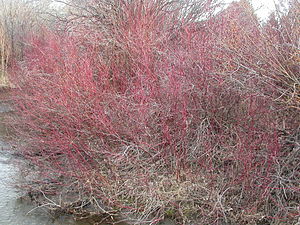Silky dogwood
| Silky dogwood | ||||||||||||
|---|---|---|---|---|---|---|---|---|---|---|---|---|

Silky dogwood ( Cornus sericea ) |
||||||||||||
| Systematics | ||||||||||||
|
||||||||||||
| Scientific name | ||||||||||||
| Cornus sericea | ||||||||||||
| L. |
The silky dogwood ( Cornus sericea ), also known as the white dogwood and sprouting dogwood , is a species of the dogwood genus ( Cornus ) in the dogwood family (Cornaceae).
description
Vegetative characteristics
The silky dogwood grows as a shrub that reaches heights of 1 to 4 meters. Its branches are spread out to arching overhanging, where they touch the ground, they can form roots. Numerous runners are also formed, so that extensive thickets quickly emerge in suitable locations.
The bark of young twigs is dark red, older twigs slowly turn gray-green; the red color is most intense in winter. The marrow is wide and white.
The opposite arranged leaves are divided into a petiole and a leaf blade. The simple leaf blade is 5 to 14, rarely up to 20 centimeters long. The upper side of the leaf is dull green and the lower side lighter. The leaf veins stand out clearly on the underside of the leaf and are curved towards the tip of the leaf. In autumn, the leaves turn red before the leaves fall.
Generative characteristics
The flowering period extends from June to July. Many flowers stand together in a truss- shaped inflorescence . The four-fold flowers are yellowish-white.
In contrast to the Tatar dogwood, the white stone fruit with a more or less spherical stone core is no longer than wide, not or only slightly pointed.
The number of chromosomes is 2n = 22.
Similar species
It is often equated with the Tatar dogwood ( Cornus alba ), which is also called the white dogwood (alba = white), to which it looks very similar outwardly, but from which it differs through the shape and size of its stone cores and its origin differs.
ecology
The fruit is mainly spread by birds, but various mammals also eat it. It is not very attractive due to its low sugar content and often hangs on the branches until well into winter.
Occurrence
The home of the silky dogwood stretches in northern North America from Newfoundland to Alaska in the north and south to the US states of Pennsylvania , Indiana , Illinois , Missouri and New Mexico as well as northern Mexico .
It grows there on soils that are well supplied with water and nutrients, on streams and in swamps, both in partially shaded locations on the edge of the forest and in the sun. The silky dogwood is often associated with willow and alder .
In some countries of Europe (eg Germany), he is a naturalized neophyte .
Systematics
The first publication of Cornus sericea was by Carl von Linné . Synonym of Cornus sericea L. is Cornus stolonifera Michx. The specific epithet sericeus means silky, stolonifera means runners.
Due to the large distribution area, individual populations of the silky dogwood differ greatly from one another. For this reason, a number of subspecies and varieties can be found in the literature , but all of them have fluid transitions and cannot be reliably differentiated. The subspecies Cornus sericea subsp. occidentalis , which is widespread in western North America and is separated from the Cornus sericea subsp. by hairiness on the shoots and leaves . sericea differs; here too there are unclear delimitations.
use
The silky dogwood is used as an ornamental shrub because of the branches that are conspicuously red in winter . Frequent pruning removes older, gray branches and encourages new, more vividly colored ones. Common varieties are 'Flaviramea' with yellow bark and 'Kelseyi'.
In the open landscape, use is made of the rapid growth and the rooted runners to avoid soil erosion . The silky dogwood is often used to secure disturbed surfaces on streams.
The long, straight and flexible branches can be used for braiding.
The inner bark used to be smoked and has a slightly narcotic effect.
Individual evidence
- ↑ a b Cornus sericea L., Silky Dogwood. In: FloraWeb.de.
- ^ Erich Oberdorfer : Plant-sociological excursion flora for Germany and neighboring areas . With the collaboration of Angelika Schwabe and Theo Müller. 8th, heavily revised and expanded edition. Eugen Ulmer, Stuttgart (Hohenheim) 2001, ISBN 3-8001-3131-5 , pp. 725 .
- ↑ USDA data sheet with photos and distribution map from the US Department of Agriculture .
literature
- MF Crane: Cornus sericea . In: US Department of Agriculture, Forest Service (Ed.): Fire Effects Information System . 1989 ( [1] [accessed February 7, 2005]).
- W. Rothmaler: Excursion flora from Germany - 4th vascular plants: Critical volume . 10th edition. Spectrum Academic Publishing House, 2005, ISBN 978-3-8274-1496-0 .
- A. Roloff, A. Bärtels: Gartenflora, Vol. 1, Woods . Eugen Ulmer, 2006, ISBN 978-3-8001-3479-3 .
Web links
- Silky dogwood . In: BiolFlor, the database of biological-ecological characteristics of the flora of Germany.
- Cornus sericea L. In: Info Flora , the national data and information center for Swiss flora . Retrieved January 11, 2016.
- Thomas Meyer: Dogwood data sheet with identification key and photos at Flora-de: Flora von Deutschland (old name of the website: Flowers in Swabia ).
- Pictures and brief description
- Photo of an inflorescence




